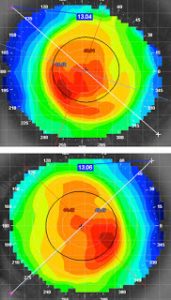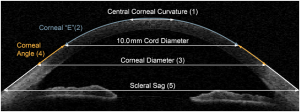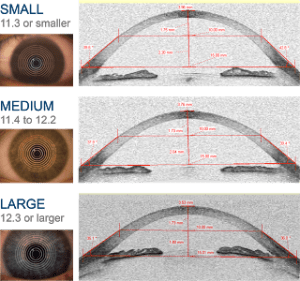The Effect of Corneal Diameter on Soft Lens Fitting
By Patrick Caroline
Today, it is well understood that knowledge of the sagittal height of the anterior eye is a key component in the fitting of both custom soft contact lenses and modern scleral lens designs. Our studies at Pacific University have identified five anatomical features that contribute to the sagittal height of the anterior segment, they include:
- Radius of curvature of the central (approximately 3.0 mm) of the cornea, often referred to as “K”
- Mid-peripheral corneal eccentricity, that extends from the apex of the cornea to a cord of approximately 10.0 mm
- Corneal angle, that begins at the 10.0 mm cord and extends to the limbus
- Overall corneal diameter
- Scleral angle that begins at the limbus and extends out to any given cord i.e. 14.0 to 16.0 mm
Five Anatomical Features that Contribute to the Sagittal Height of the Anterior Eye
The Role of Corneal Diameter
All too often, practitioners select the radius of their soft contact lenses based solely on central keratometric measurements. Yet, for many years we have known that corneal diameter dominates, as the major contributor to the height of the anterior segment. As a general rule, smaller diameter corneas exhibit less sagittal height and conversely, larger diameter corneas exhibit greater sagittal height. This is clearly illustrated in the picture on the left, which profiles corneas with small, medium and large, corneal diameters.
In an effort to better understand the diversity of corneal diameter in the population, we measured the Horizontal Visible Iris Diameter (HVID) of 300 consecutive right eyes in our contact lens practice. In our study, the average HVID was 11.8 mm with a range of 10.9 mm to 12.7 mm, diagram below.
Today, most commercially soft lenses are available in only one diameter and, at most, two base curve radii. These “off-the-shelf” soft lenses are designed to fit approximately 80% of our prospective contact lens patients. That leaves a significant number of individuals that require a lens designs outside of the commercially available lens parameters.
Case History
 (Top) left eye, (bottom) right eye
(Top) left eye, (bottom) right eye
One such case is patient JF who is a 28 year old professional, NBA basketball player with moderate hyperopia and large diameter corneas. The patient had failed with multiple attempts with “off-the-shelf” soft lenses and was referred to our clinic for evaluation. Upon initial presentation, the patient had central K readings of right eye 43.25 / 44.37 and left eye 43.37 / 45.62 a spectacle Rx of +2.50 and +3.75 and corneal diameters of right eye 13.04 and left eye 13.06.
His anatomical data was placed into an Arch Length Calculator which indicated that he needed lenses with a BOZR of 8.6 mm with an overall diameter of 16.0 mm. The lenses were ordered in the Contamac Definitive material and were dispensed to the patient. He placed them on and report that they were the most comfortable lenses he had ever worn and today he wears the lenses 14 to 16 hours a day with excellent comfort and vision.
Right and left eye – 16.0 mm Custom Soft Contact Lenses
This patient’s history of discomfort with “off-the-shelf” soft contact lenses was undoubtedly due to a failure of his previous practitioners to recognize the role of corneal diameter in 1. determining overall soft lens diameter and 2. the contribution of his large corneal diameters to the sagittal height of his anterior segment.

Thank you to Patrick Caroline, COT, for contributing to Global Insight.

Professor Caroline serves as an instructor and lecturer at the Pacific University College of Optometry in Forest Grove, Oregon. He is a Fellow member and Diplomat of the Cornea and Contact Lens Section of the American Academy of Optometry. He has published over 300 papers on a wide range of contact lens topics and has lectured extensively throughout the world.



